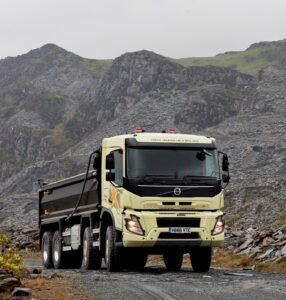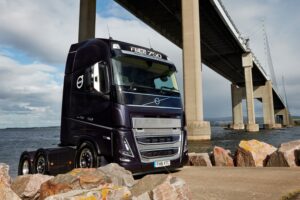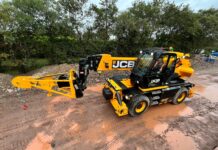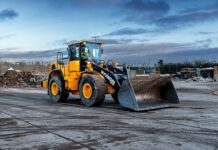The introduction of four new heavy trucks by Volvo marks the company’s biggest ever product launch, featuring a full line-up of new tipper models.
As launch strategies go, overhauling 70 per cent of your existing truck range in one go could be seen as a fairly bold approach. But then again, Volvo Trucks has form – and isn’t keen on doing things by halves!
This autumn the company has opened its order books for the brand-new FMX and FM, which have a strong heritage in the construction, plant and quarrying sectors. At the same time it has unveiled a revamped and refurbished FH and FH16 – popular for step frame and low loader work in the plant sector, amongst many other missions.
The overriding focus for all four new and improved trucks is – the driver. A more than sensible approach when you consider the pressure on the availability of skilled drivers worldwide. Research conducted at the start of the year found that in Europe, around 20 per cent of all driver jobs are vacant. A point clearly not lost on Volvo, which claims these new trucks will help that recruitment process by offering “safer, more efficient and more attractive working tools.
“We are really proud of this big forward-looking investment. Our aim is to be our customers’ best business partner by making them even more competitive and help them attract the best drivers in an increasingly tough market,” says Roger Alm, President of Volvo Trucks.
“Drivers who handle their truck safely and efficiently are an invaluable asset to any transport company. Responsible driving behaviour can help reduce CO2 emissions and fuel costs, as well as helping reduce the risk of accidents, injury and unplanned downtime. Our new trucks will help drivers work even more safely and productively and give our customers stronger arguments when competing to attract the best drivers.”
Taking a closer look, Volvo certainly appears to have backed up those claims.
The new trucks have been given a significant interior overhaul. The dashboard has a completely new interface for information and communication, making it easier to view and manage different functions aimed, Volvo say, to “create less stress and distraction” for the driver.
The instrument display is fully digital, with an impressive 12-inch screen that makes it easy to choose the information needed at any time. In addition, there is a supplementary nine-inch side display available for infotainment, navigation, transport information and camera monitoring. The functions can be controlled via buttons on the steering wheel, by voice control, or via the touchscreen and display control panel.
It’s a very nice bit of technology, that improves the driver experience across all four ranges. However, the changes to the all-new FMX and FM go even further.
Volvo FMX
The all-new FMX is a fine-looking truck, and likely to be the most popular amongst Plant & Civil Engineer readers. With increased front axle loads of up to 20 tonnes and a new 38 tonne bogie, this latest-generation FMX is built on an entirely new cab platform, based on Volvo’s long and successful experience of delivering robust and functional construction trucks for the “toughest conditions and most demanding assignments.”
 The new cab includes a front section with replaceable sturdy parts, headlamp protectors, anti-slip footsteps and new V-shaped LED headlamps.
The new cab includes a front section with replaceable sturdy parts, headlamp protectors, anti-slip footsteps and new V-shaped LED headlamps.
Space in the FMX day cab is improved with storage of up to 800 litres. A lowered door line improves visibility, which can be boosted further by adding a camera on the passenger side which provides a complementary view of the side of the truck.
The new FMX also comes equipped with a new traction control panel that helps the driver easily and quickly handle potentially dangerous situations, both on and off the road. A new steering wheel with a neck tilt option offers the driver a more ergonomic driving position.
The 38-tonne bogie allows for a Gross Combination Weight (GCW) of up to 150 tonnes. In addition, the front air suspension has been updated, allowing for front axle loads of up to 10 tonnes, or 20 tonnes for double front axles. For trucks with a steered tag or pusher axle, the steering angles have been increased, resulting in better manoeuvrability and reduced tyre wear.
 Unsurprisingly, safety is at the heart of Volvo’s new range, with advances in the new FMX including descent control and Adaptive Cruise Control (ACC) that now work at all speeds down to zero km/h.
Unsurprisingly, safety is at the heart of Volvo’s new range, with advances in the new FMX including descent control and Adaptive Cruise Control (ACC) that now work at all speeds down to zero km/h.
The Electronic Brake System (EBS) now comes as standard and is supplemented by additional safety features such as Collision Warning with Emergency Brake and Electronic Stability Control. Volvo Dynamic Steering is available as an added option.
For particularly rough applications, like mining or quarry work, Volvo can even include an optional steel roof hatch with an emergency exit handle that removes the entire hatch.
Volvo FM
Tagged as the “versatile work horse” of Volvo’s range, the new FM will also be popular amongst tipper operators, being ideal for use around urban areas, over long distances and even navigating construction sites
It has raised A-pillars that give the cab up to one extra cubic metre of space and far more light than before. Larger windows and a lower doorline improve visibility further, and both the FM and FMX have now been fitted with the slimline rear-view mirrors found in the FH.
The new FM sleeper cab has been upgraded with a raised bed and greater storage, including a substantial compartment underneath the bed. To move from the seat to the bed is easier with a new slimmer, ergonomically designed I-Shift gear selector. Reinforced insulation helps keep out cold, heat and noise.
The exterior of the FM also gets a significant redesign, with a new aerodynamic shape and distinctive lines on the front. The distinctive Volvo V-shaped headlamps remain, although repositioned ever so slightly for “optimal aerodynamics”, and the larger brand identity panel and upper front grille with a new mesh pattern give the truck a bold, confident look.
The variety of driveline and chassis configurations available means the new FM can be tailored to deliver higher productivity and fuel savings in a wide range of applications. Improvements to the steering angles of the tag and pusher axles also give the truck exceptional manoeuvrability.
Volvo FH and FH16
While the FH and the flagship FH16 may only have had a facelift, these next generation trucks still feature some impressive improvements.
 On the outside, both trucks are again characterised by the V-shaped headlamps. The lights and indicators have been moved outwards. The FH16 also features a distinctive waterfall-type grille that, according to Volvo, builds on the “strong character and heritage of the Volvo flagship model”.
On the outside, both trucks are again characterised by the V-shaped headlamps. The lights and indicators have been moved outwards. The FH16 also features a distinctive waterfall-type grille that, according to Volvo, builds on the “strong character and heritage of the Volvo flagship model”.
However, the bigger changes for both the FH and FH16 can be found inside the cab, with the new 12-inch and nine-inch digital screens highlighting a much-improved updated dashboard. The main screen is configurable, allowing drivers to choose between four different views.
Building on its predecessor’s impressive fuel economy credentials, the new FH can be tailored to suit a wide range of applications and enable even greater fuel and CO2 savings using various driveline and chassis configurations.
The new Volvo FH also offers the popular I-Shift Dual Clutch transmission –allowing gear changes without power interruptions. The dual clutch transmission is particularly beneficial during demanding operations.
Volvo believes they have boosted productivity further due to the FH’s capacity for increased front axle loads, as well as tag and pusher axles with improved steering angles to reduce tyre wear and improve manoeuvrability – essential when making deliveries to construction sites with limited space. The truck is also available with tandem axle lift, enabling the rear axle to be disengaged and raised when the truck is not loaded, another nice little addition to lessen fuel consumption further and tyre wear.
The new FH16 – powered by a 16-litre engine generating up to 750 hp – benefits from increased front-axle load capacity, and tag and pusher axles with better steering angles. While a new 38-tonne bogie is also available for especially demanding operations.
Overall, Volvo looks to have delivered another solid and impressive range of heavy trucks that will take driver experience to new heights. The Swedish manufacturer continues to be a reassuringly safe pair of hands, particularly in these most uncertain of times, and we expect the first next generation models to enter operation in Ireland towards the end of Q1 2021. Order books open on 28 September!

















